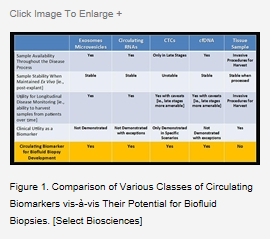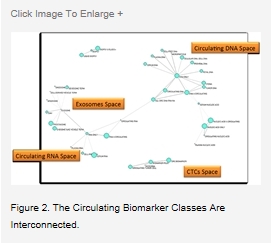기술동향
Using Circulating Biomarkers for Cancer Diagnostics Development
- 등록일2015-04-28
- 조회수4242
- 분류기술동향 > 레드바이오 > 의약기술
-
자료발간일
2015-04-20
-
출처
GEN
- 원문링크
-
키워드
#Biofluid-Based Biopsies#Using Circulating #Biomarker#Cancer#Biofluid
Biofluid-Based Biopsies
Using Circulating Biomarkers for Cancer Diagnostics Development
Enal Razvi, Ph.D.

There is mounting evidence that biofluid biopsies will migrate toward the point-of-care setting. [ⓒ AlexRaths/iStock]

There is increasing interest in the potential of circulating biomarker classes as a means to developing minimally invasive biopsies primarily for cancer but with penetrance into many other disease classes such as CNS disorders. Several circulating biomarker classes are being studied in this context most notable of which are circulating free DNA (cfDNA), circulating RNA, circulating tumor cells (CTCs), and extracellular vesicles (EVs)-these various classes represent either the biomarkers themselves or the vectors carrying the circulating biomarkers (Figure 1).
Which Biofluid to Utilize?
One of the challenges in the development of biofluid biopsies is the “sample preparation” on the front-end from clinically relevant patient samples.
Currently, the most commonly studied biofluid samples are:
Whole Blood-for CTC Capture
Plasma-for Extracellular Vesicles (EVs) and Extracellular Nucleic Acids
Serum-for Extracellular Vesicles (EVs) and Extracellular Nucleic Acids
Urine-for Extracellular Vesicles (EVs) and Extracellular Nucleic Acids
Less common biofluid classes:
Cerebrospinal fluid (CSF)
Biofluid Biopsies Will Migrate Eventually to the Point-of-Care (POC) Setting
There is mounting evidence that biofluid biopsies will migrate toward the point-of-care (POC) setting for the following reasons:
Beyond cancer, biofluids may be harvested for other disease classes including traumatic brain injury (TBI) where biopsies of the brain are not feasible and biofluids offer an important alternative-diagnoses of TBI must necessitate movement toward the POC setting
If biofluids are to be deployed for routine cancer screening in otherwise clinically healthy subjects, this of course must be performed in doctor’s offices, outpatient clinics-the POC setting
Technology development for POC diagnostics such as smartphone-based diagnostics is proceeding at a rapid pace and we believe that these technologies will impact biofluid-based diagnostics especially in resource-limited settings and for public health
Categorization of Potential Circulating Biomarker Classes to Illustrate Associations Amongst the Publications and Therefore the Intersections of the Various Spaces

Select Biosciences has sought to segment the various circulating biomarker classes and forge connections between these classes based on the scientific publications wherein these circulating biomarkers are mentioned. Figure 2 presents this segmentation and provides a compelling argument for the interconnectivity of these biomarker classes and the postulate that biofluid biopsy development will necessitate combinations of these various circulating biomarker classes.
Taken together, our tracking of this marketplace reveals that the various circulating biomarker classes offer opportunity for biofluid biopsy development-at this point in the trajectory of the field it appears that “each” of these circulating biomarker classes will have a role to play and the future of biofluid biopsies is most-likely a combination of several circulating biomarkers providing a real-time picture into the trajectory of the disease progression and responsiveness to the treatment regimen.
...................(계속)
☞ 자세한 내용은 내용바로가기 또는 첨부파일을 이용하시기 바랍니다.

